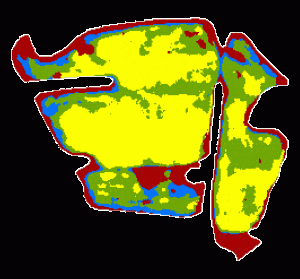Composite satellite images that show long-term yield trends have traditionally not correlated well with soil tests. This suggests that dominant forces in yield sustainability are not being captured in the way soil testing is conducted. Soil health tests also are not correlating well with apparent soil management. Yet, a new study reported by Dr Basso and Brinton at the ASA-SSSA Meetings in 2021 Salt Lake City suggests this discrepancy may be in how the soil sampling is performed.
- A 10 farm study was conducted across MI, IL and IN using satellite composite images to determine where to best soil sample. Each farm site was divided into zones being either consistently low, medium or high yielding. Then the mobile soil probe team equipped with GPS trackers sought-out and took samples consistent with the pre-determined zones, triplicating each across the farms.
- The study was a joint operation of Woods End Labs, MSU digital agronomy lab and Deveron Corp., a Woods End JV partner. An integrated soil health package called Solvita® Nexus by Woods End labs was used to integrate data into soil health and fertility index scores.
-

Yield stability zones on a farm based on 8-years of NDVI imaging. (MSU Basso Digital Lab)
A total of 56 test traits were gathered for each site at two soil depths. Included in the matrix of tests are Nexus (chemical, biological and physical) plus new microbial substrate utilization protocols under joint-venture development between Woods End and A&L Biologics, Canada.
- Analysis showed highly significant interaction effects of Farm x Stability Zone suggesting that spatial variations across regions will challenge general predictability of tests. However, within each farm, an overriding and highly-significant correlation of stability zones with Solvita Nexus soil health tests was revealed. A key trait was the single test- soil organic carbon (SOC).
- Using machine-learning (non-linear) modeling such as boosted and forest protocols, SOC as a determinant lost much of its significance and instead several biological traits complexed with mineral-imbalance indicators like aluminum, emerged as highly linked – a result pointing to an enormously complex set of soil-plant relationships.
- A video recording of the 15′ presentation is available on the Agronomy Society website: https://scisoc.confex.com/scisoc/2021am/meetingapp.cgi/Paper/138888
According to Brinton, Founder of Woods End, “It should be reassuring to see that tests and indicators developed ad-hoc by independent scientists and farmer groups can have such high correspondence to important farm yield traits.” The findings are considered preliminary, however: they imply that a large shift in common soil testing approaches must be undertaken. Soil sampling and testing as commonly practiced is clearly not capturing spatial variance adequately: this will become increasingly necessary to fulfill the real potential of soil health testing. “Its going to mean collaborations of the kind we have established here” commented Brinton.

